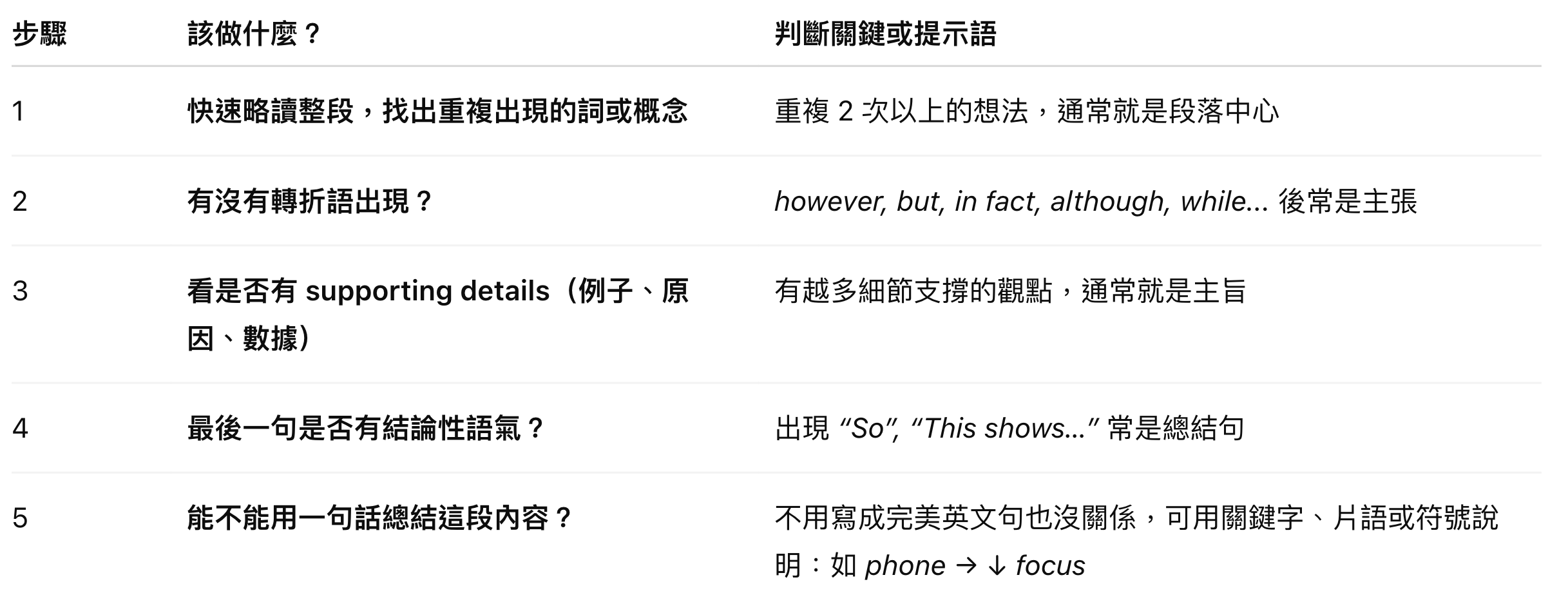你是見樹不見林,還是見林不見樹?——教你如何找出每一段的主旨句,破解雅思閱讀難題!

很多人在閱讀英文文章時,常常遇到這樣的困擾:「我每一句都看懂,但還是不知道這段到底在說什麼….」這其實不是英文程度的問題,而是缺乏「找主旨」的能力。主旨(main idea)是一段或一篇文章的核心,它不一定會直接寫出來,更多時候是要你從語意邏輯中推論出來。
為什麼學會找主旨這麼重要?
在 IELTS 閱讀測驗中,Matching Headings、Summary Completion、Multiple Choice 題型都仰賴你快速抓出段落重點。不僅可以節省閱讀時間,更可以避免掉入細節陷阱──這正是高分考生的閱讀習慣。
找主旨不只是為了雅思可以得高分,更是之後出國留學的核心技能。
想像一下:你出國念書,教授每天給你 30 頁以上的學術文章,還要寫報告、做簡報。你不可能逐字慢讀、逐句翻譯。這時如果你有「找主旨」的能力,就能先掌握重點,再決定哪些部分需要深入閱讀。出社會後也是一樣——寫報告、看產業資料、閱讀國際新聞,全都仰賴你快速抓出文章重點的能力。
學會找主旨,就是學會如何有邏輯地理解世界。
找主旨的實用流程(適合任何英文文章)

段落示範
範例一:
Many people think that drinking coffee late at night will keep them awake. However, recent studies have shown that the effect of caffeine depends on the individual’s metabolism and sleep habits. Some people are more sensitive to caffeine, while others can fall asleep easily after a cup of coffee.
主旨推理邏輯:
重複出現 caffeine / sleep → 主題範圍明確
第二句 “However...” 是關鍵 → 後面「作者的主張」出現,且與一般人的想法不同
最後一句舉例 → 支撐第二句主張
✅ 主旨可寫成:Caffeine affects people differently depending on the person. 或是用自己的方式筆記☕ ≠ same effect on everyone (每個人對咖啡因反應不同)
範例二:
Using your phone while working can reduce your focus. Notifications constantly interrupt your thoughts and make it harder to stay in the zone. Even checking your phone for a second can break your flow and lower your productivity.
主旨推理邏輯:
第一句及為主題句,剩下兩句話都圍繞同一個概念:「手機會干擾專注力」
沒有轉折語,沒有多重觀點 → 結構單一但重複清楚
第二、三句是具體例子 → 支撐第一句主張
✅ 主旨可寫成:phone → ↓ focus / ↓ productivity
或:phones are a major distraction while working
📌小提醒:有些段落會把主旨放在開頭(topic sentence),有些段落則會放在結尾作總結(尤其是學術型文章),所以請不要只看一句話,而是看整段的邏輯關係與支撐方式。
雅思閱讀文章示範
今天用劍19裡Test 1, Passage 3裡《The persistence and peril of misinformation》裡的第一個段落,帶大家快速找對主旨。
第一段
Misinformation – both deliberately promoted and accidentally shared – is perhaps an inevitable part of the world in which we live, but it is not a new problem. People likely have lied to one another for roughly as long as verbal communication has existed. Deceiving others can offer an apparent opportunity to gain strategic advantage, to motivate others to action, or even to protect interpersonal bonds. Moreover, people inadvertently have been sharing inaccurate information with one another for thousands of years.
主旨推理邏輯:
第一句明確點出主題:Misinformation… is not a new problem,最後一句延伸強調:inaccurate information… for thousands of years → 開頭和結尾首尾呼應,主旨範圍穩定,都是在講「假訊息歷史悠久」
中間內容並無轉折語,不用擔心主旨有變,且補充「假訊息歷史悠久」的原因(strategic, emotional, interpersonal reasons)
因此可以得出主旨:Misinformation has long existed and is often shared for certain reasons. 或是 misinformation = long history + human reasons(假訊息 = 古早就有 + 人類會這樣做有原因)。
掌握主旨的能力,不只幫助我們理解段落大意,也直接影響解題效率。就以 Paragraph 1 為例,對應到 Cambridge IELTS 19, Test 1 的第 27 題:
Q27. What point does the writer make about misinformation in the first paragraph?
A. Misinformation is a relatively recent phenomenon.
B. Some people find it easy to identify misinformation.
C. Misinformation changes as it is passed from one person to another.
D. There may be a number of reasons for the spread of misinformation.
如果你一開始就根據段落做出像這樣的筆記:
Misinformation = long history + human reasons
那麼你會發現:
“long history” → 直接排除選項 A(說它是 recent)
“reasons” → 這就是選項 D 的關鍵字
B 和 C 都沒有出現在段落或筆記裡 → 自然也能排除
換句話說,只要筆記做對,關鍵字就能幫你對應正解選項,節省思考時間又更有邏輯。這就是高分考生的閱讀習慣:不執著於句句翻譯,而是先抓出「段落在說什麼、為什麼說」,然後再從選項中比對、排除、作答。
結論!找主旨不是找一句「看起來重要」的句子,而是練習你的邏輯思維!
作者簡介|周君璘
師大英語教育研究所碩士畢業。擁有超過十年英語教學經驗,曾教授數百名來自不同背景的學員,累積豐富的實務教學與課程設計經驗。專精於師資培訓與教學法設計,擅長協助教師掌握有效的課堂管理技巧與語言教學策略,並設計多場講座與培訓課程。

